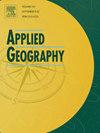The effects of green apartment living, neighborhood greenspace exposures and greenspace exposures in activity space on residents’ walking behaviors and mental health in China
IF 4
2区 地球科学
Q1 GEOGRAPHY
引用次数: 0
Abstract
Many evidences have proved that residents' health outcomes are influenced by their overall living environments. However, existing literature mainly stresses the effects of outdoor greenspace exposures on health and little is known about the compound effects of indoor and outdoor, static and dynamic, and over-head and eye-level greenspace exposures. This study aims to make multi-scale comparison into relationships between greenspace exposures and health by incorporating the geographical contexts of indoor green apartment living, static greenspace exposure within neighborhood, dynamic greenspace exposure in daily activity space, and the perceived greenspace exposure in general in Nanjing China. We conducted a cross-sectional survey among 132 green apartment occupants and 170 conventional apartment occupants aged 18 years old and over from March to June 2018 in Nanjing with rich resources of greenspace and green building developments. Respondent's walking behavior was assessed by the International Physical Activity Questionnaire. Respondent's mental health status was acquired from the Warwick-Edinburgh Mental Wellbeing Scale. This study employed multi-sourced greenspace assessments based on remote sense data, digital map data, street view image data, and machine learning interpretation methods. Partial least square structural equation modeling was chosen to analyze the pathways underlying the greenspace exposure-health associations. Results show that green apartment living does not exert much influence on residents' walking activities and mental health. People choose to live in green residential buildings does not mean that they choose to lead a green life. It is the outdoor objective and subjective greenspace exposures influencing residents' outdoor activities and mental health. After controlling for neighborhood exposure and perception indicators, greenspace exposure in activity space influenced physical activity intensity and health. Residents who enjoy good visibility and diversity of outdoor greenspace in their mobility path could show better health performance. The effects of activity space green exposures on health were bigger for the elderly and female than for the non-elderly and male respectively. The results could shed light on comprehensive green community design and green city planning.
中国绿色公寓生活、邻里绿地暴露和活动空间绿地暴露对居民步行行为和心理健康的影响
许多证据证明,居民的健康状况受到其整体生活环境的影响。然而,现有文献主要强调室外绿地暴露对健康的影响,对室内与室外、静态与动态、头顶与眼平面绿地暴露的复合效应知之甚少。本研究旨在通过结合南京室内绿色公寓生活的地理背景、社区内的静态绿色空间暴露、日常活动空间中的动态绿色空间暴露和感知绿色空间暴露的总体情况,对绿色空间暴露与健康的关系进行多尺度比较。本研究于2018年3月至6月,在绿地和绿色建筑开发资源丰富的南京市,对132名18岁及以上的绿色公寓居住者和170名普通公寓居住者进行了横断面调查。采用国际身体活动问卷对被调查者的步行行为进行评估。被调查者的心理健康状况通过沃里克-爱丁堡心理健康量表获得。本研究采用基于遥感数据、数字地图数据、街景图像数据和机器学习解释方法的多源绿地评估。选择偏最小二乘结构方程模型来分析绿色空间暴露与健康关联的潜在途径。结果表明,绿色公寓生活对居民步行活动和心理健康没有太大影响。人们选择居住在绿色住宅并不意味着他们选择过绿色生活。室外客观和主观绿地暴露对居民户外活动和心理健康的影响。在控制邻里暴露和感知指标后,活动空间中的绿地暴露对身体活动强度和健康有影响。居民在其移动路径上享有良好的可视性和多样性的室外绿色空间,可以表现出更好的健康表现。活动空间绿色暴露对健康的影响在老年人和女性中分别大于非老年人和男性。研究结果可为绿色社区综合设计和绿色城市规划提供参考。
本文章由计算机程序翻译,如有差异,请以英文原文为准。
求助全文
约1分钟内获得全文
求助全文
来源期刊

Applied Geography
GEOGRAPHY-
CiteScore
8.00
自引率
2.00%
发文量
134
期刊介绍:
Applied Geography is a journal devoted to the publication of research which utilizes geographic approaches (human, physical, nature-society and GIScience) to resolve human problems that have a spatial dimension. These problems may be related to the assessment, management and allocation of the world physical and/or human resources. The underlying rationale of the journal is that only through a clear understanding of the relevant societal, physical, and coupled natural-humans systems can we resolve such problems. Papers are invited on any theme involving the application of geographical theory and methodology in the resolution of human problems.
 求助内容:
求助内容: 应助结果提醒方式:
应助结果提醒方式:


